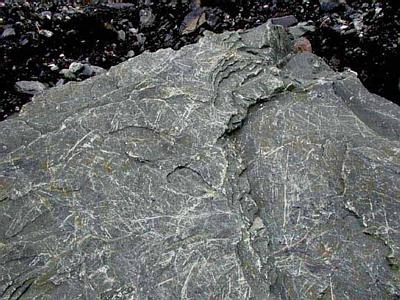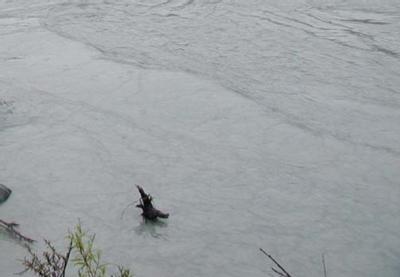21 July, 2000
July 21, 2000
Matanuska Glacier, Alaska
Today’s time has been occupied primarily with analyzing samples that
were collected during yesterday’s dye experiment. After the samples were
drawn from the ISCO bottles they were filtered to remove whatever
parcticles remained suspended in the water. They were then transferred to
special holders called cuvettes and placed into the fluorometer. The
concentration of dye was then recorded. So far there has been no
measurable trace of dye in the samples that have been tested. There are
still a lot more to be measured so it’s wait and see time.
The water emerging from the vents carries with it many types of solid
parcticles. It appears to be similar in appearance to the muddy
floodwaters in Indiana except that it has a very gray color. The size of
these parcticles varies but it is very obvious that there is lots of
suspended sediment called “glacial flour” that emerges. Suspended
sediment consists of parcticles of any material that are small enough
that they will stay mixed with the water for some time, but eventually
settle to the bottom when allowed to sit still for a period of time. The
Matanuska River which is formed from these waters keeps the same gray
color of the water emerging from the vents all the way to Cook Inlet
where its flow finally stops. At this point the waters are stilled and
the sediment settles to the bottom, slowly but surely filling in this
inlet.
The water rushing into the moulins is extremely pure and yet somewhere
along the way it has to pick up this sediment. The moulins are simply
holes at the surface of the glacier which funnel the water into a
complex system of conduits. The drainage system eventually makes its way
down to the interface between the basal ice at the bottom of the glacier
and the earth where it joins the subglacial drainage system. The
subglacial drainage system is loaded with sediment. Where does this
sediment come from? As a glacier moves along it dislodges rocks and
boulders along the way and carries them with it. As these rocks move
they scrape and scratch the bedrock beneath them as well as each other.
If you were to rub two rocks together they would produce a fine powder.
Under the glacier these rocks are worked so much that they lose their
jagged edges and become rounded instead much like rocks that get rounded
by rolling surf at the ocean or a large lake. The powder that gets
produced by this scraping gets washed away by the subglacial waters that
flows beneath the glacier.
We need to remove these suspended parcticles because they cause
scattering and to some extent blocking of the UV light that the
fluorometer produces. In my July 13 journal I mention that this UV light
will cause certain materials such as our dye to give off light or
fluoresce. When the UV light is scattered the scattered light
interferes with the sensor and prevents it from giving an accurate
readout. To some extent the parcticles also absorb or block the UV from
hitting all the dye molecules. The more molecules that are exposed, the
more fluorescence will be produced. A somewhat impure sample would
produce less fluorescence than the same sample after filtering due to
this interference. Obviously we want to have all samples free from these
problems that would give inaccurate results. Hopefully tomorrow we will
be able to finish the analysis and get some good results.
Marvin Giesting

This is just part of a huge boulder I saw yesterday on my hike back from reprograming the Little River ISCO. It was maybe eight feet wide and twelve long and six feet thick. You can see scratches all over its surface from being scraped by other rocks as it was moved along by the glacier. All these scratches produced lots of small parcticles and sediment that easily wash out in the subglacial drainage system to give the stream here a gray color. Other colors of rock will of course produce a different color of sediment but this is the predominant color of the rocks in the Chugach Mountains.

This is water at North Vent and shows the color of the glacial flour in the streams flowing out of the Matanuska Glacier. I have seen streams with other colors coming down from the Talkeetna Mountains to the north on our way back and forth to the grocery store. The color depends on the predominant rock type in the source mountains that the glacier scours. It's interesting to see where streams with different colors meet. The resulting stream is half and half for awhile until the mixing is complete.
Contact the TEA in the field at
.
If you cannot connect through your browser, copy the
TEA's e-mail address in the "To:" line of
your favorite e-mail package.
|
